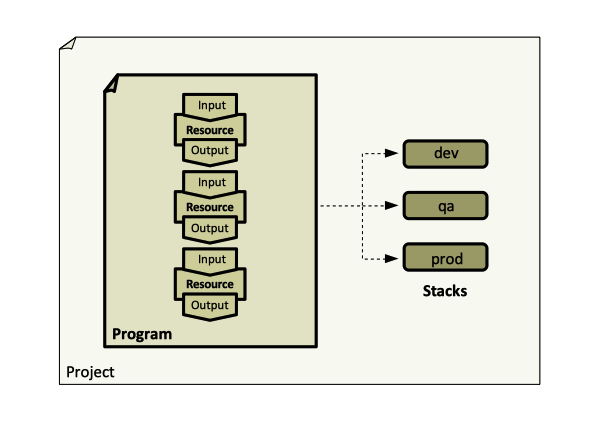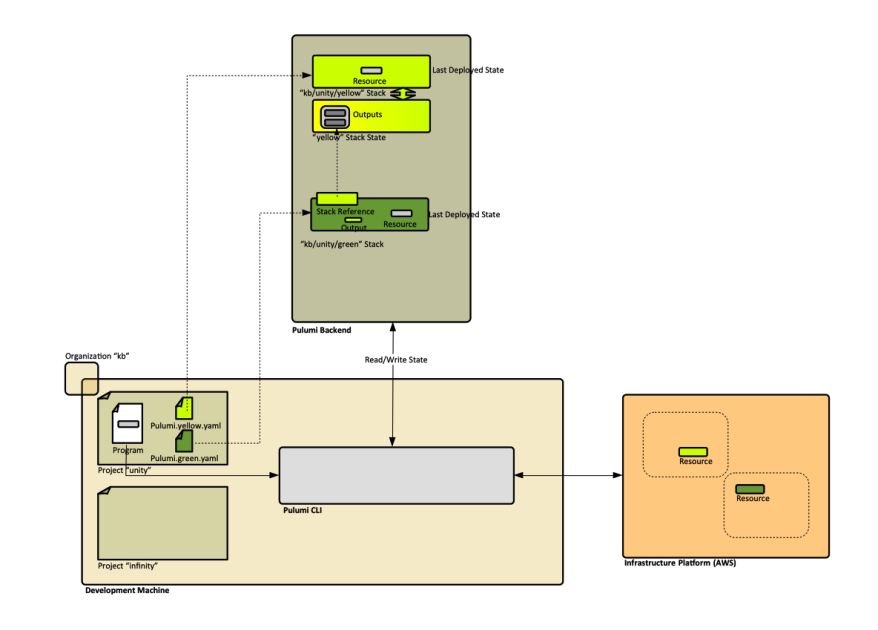Pulumi Concepts
External
Internal
Overview
Pulumi is an Infrastructure as Code platform that allows using common programming languages, tools, and frameworks, to provision, update, and manage cloud infrastructure resources. Pulumi is one of the tools that can be used to manage generic Infrastructure as Code stacks. In Pulumi, Infrastructure resources are declared in programs. Programs reside in a project. The programs are instantiated as stacks in the infrastructure platform. A stack is an isolated and configurable instance of the program.
Architecture
TO PROCESS: https://www.pulumi.com/docs/intro/concepts/how-pulumi-works/
Organization
Other organization is also referred to as the "owner".
- Relationship between a stack and an organization ("owner"). "New stack owner, some-org, does not match existing owner, o_feodorov."
Project
A project is a directory that contains a program and metadata on how to run the program, such as what runtime to use, where to look for the program, etc. The project definition metadata is maintained in Pulumi.yaml. The presence of Pulumi.yaml is the indication that directory is a Pulumi project.
Projects can be created with pulumi new command.
The program and metadata are read by the Pulumi CLI and applied to the infrastructure platform with the pulumi up command, creating a stack.
- Is the project stored in the backend after
pulumi new. How can it be listed? - Does the stack need to be created explicitly or
pulumi newdoes it implicitly? - Understand the relationship between a project and stacks. Can a project contain more than one stack? How does the project layout look like in that case?
Current Project
The current project is the project given by the nearest Pulumi.yaml file.
Project Name
Template
A list of available templates is presented executing pulumi new without any argument. An example is available here:
Intuitively, the right template can be invoked by using the name of the cloud and the language, example: aws-python.
Project Layout
my-project ├─ README.md ├─ Pulumi.yaml ├─ Pulumi.my-stack.yaml └─ ... # language-specific elements
Language-specific layouts:
Pulumi.yaml
Contains the project definition. The name must begin with a capital "P", and both "yaml" and "yaml" extensions are valid.
Example:
name: simple-aws
runtime:
name: python
options:
virtualenv: venv
description: An experimental AWS Pulumi project.
Built-in Tags
pulumi:project
pulumi:runtime
Example of a Python runtime section.
pulumi:description
gitHub:owner
gitHub:repo
vcs:owner
vcs:repo
vcs:kind
Program
A program contains code that describes how cloud infrastructure should be composed. It can be written in Python, TypeScript or Go. Infrastructure is declared by defining resource objects whose properties correspond to the desire state of the infrastructure. The properties are also used to express dependencies between resources, and can be exported outside the stack. It is recommended to group resource with common lifecycles together. Programs reside in projects.
Supported Runtimes and Programming Languages
Python
The runtime name is python.
TypeScript
The runtime name is nodejs.
Go
The runtime name is go.
.NET
The runtime name is dotnet.
Programming Model
The Pulumi programming model defines the core concepts in use when creating infrastructure as code programs. These concepts are made available in the Pulumi SDKs, that support Python, TypeScript and Go.
Resource
TO PROCESS: https://www.pulumi.com/docs/intro/concepts/resources/
Pulumi understands dependencies between resources and uses the relationship between resources to maximize execution parallelism and ensure correct ordering when a stack is instantiated.
Property
Difference between resource and stack inputs/outputs.
Input Property
Output Property
Stack
A stack is an isolated, independently configurable instance of a Pulumi program. Stacks are commonly used to denote different phases of development, such as "development", "staging" and "production", or feature branches. A project can have an arbitrary number of stacks. By default, Pulumi creates a new stack per project when pulumi new is used.
Stack Name
A fully qualified stack name includes the organization and the project name: <org-name>/<project-name>/<stack-name>.
Stack URI
What is the semantics of a stack URI?
Current (Active) Stack
The current stack for a project can be displayed by running pulumi about in the project, and can be set by running pulumi stack select.
Stack References
Stack references are used by consumer stacks to get their dependencies, using the Stack Data Lookup pattern.
Stack Tags
Stacks have associated metadata as tags. Each tags has a name and a value. A set of built-in tags are automatically assigned and updated each time is updated). Tags are only supported with the Pulumi Service backend.
Stack Output
Stack outputs can be shared with other teams.
Destroying and Deleting a Stack
Destroying a stack means releasing and deleting resources associated with the stack. Pulumi waits until all resources are shut down and deleted before it considers the destroy operation to be complete.
Deleting a stack means removing all stack history from the backend and the stack configuration file Pulumi.<stack-name>.yaml.
⚠️ Forcefully deleting a stack before destroying it may leave orphaned resources behind.
Stack Settings File
Each stack of a project will have a file named Pulumi.<stackname>.yaml that contains configuration (key/value pairs) specific to the stack it is associated with. The file typically resides in the project root directory. Secret values are encrypted, which, according to the Pulumi documentation, makes them safe to be checked in into a repository. This is debatable. The stack settings for ephemeral stacks are typically not checked into source control.
Ephemeral Stack
Ephemeral stacks may have stack settings files.
Stack Operations
- List stacks
- Select a stack
- Display stack resources
- Display stack tags
- Create a stack
- Select a stack
- Remove (delete) a stack
Configuration
TO PROCESS when I have access to a working environment so I can try code: https://www.pulumi.com/docs/intro/concepts/config/
Namespace
Key space.
Inputs and Outputs
The Pulumi programming model includes the concepts of Input and Output values, which model how output of one resource flow in as inputs of another resource.
See stack outputs.
- TO PROCESS: https://www.pulumi.com/docs/intro/concepts/inputs-outputs/
pulumi.Output.concat(...)
State and Backends
TO PROCESS: https://www.pulumi.com/docs/intro/concepts/state/
State can be interacted with via both #CLICLI and programming model.
What Happens when Code Is Applied to Platform?
The pulumi up command evaluates the program and determines resource updates to make. Part of the update process, pulumi will run the preview step of the update, which computes the minimally disruptive change to achieve the desired state described by the program.
More here.
Backend
The main job of a service backend is to reliably manage the state of stacks. It provides dependencies to consumer stacks via the Stack Data Lookup pattern.
Name
URL
Authentication and Identity
The backend decides what a user can and cannot see, for example organizations, based on user's OD group configuration. A user's OD group list, as known by the Pulumi backend, is given by pulumi whoami --verbose.
Service Backend
Secrets
TO PROCESS: https://www.pulumi.com/docs/intro/concepts/secrets/
Logging
TO PROCESS: https://www.pulumi.com/docs/intro/concepts/logging/
Assets and Archives
TO PROCESS: https://www.pulumi.com/docs/intro/concepts/assets-archives/
Plugin
Plugin Operations
Function Serialization
TO PROCESS: https://www.pulumi.com/docs/intro/concepts/function-serialization/
Workspace
Modularization
TO PROCESS: https://www.pulumi.com/blog/creating-and-reusing-cloud-components-using-package-managers/
Packages
Pulumi Registry
CLI
Pulumi vs Terraform
Also see:

